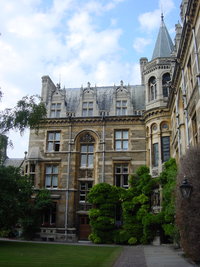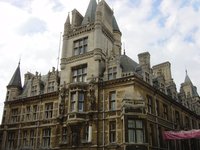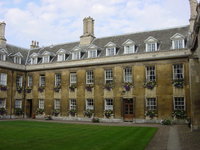Gonville and Caius College, Cambridge
|
|
Template:Oxbridge College Infobox Gonville and Caius College, Cambridge, generally known as Caius (pronounced "Keys"), is a constituent college of Cambridge University. The college has produced many academically-accomplished alumni, including several Nobel Prize winners.
The college first admitted women as fellows and students in 1979. The college now has nearly 100 fellows, over 700 students and about 200 staff.
Gonville and Caius also very selectively admits American and other foreign students for its various summer programs, the most prominent of which has been organized in the United States by the University of New Hampshire.
| Contents |
History
The college was first founded, as Gonville Hall, by Edmund Gonville, Rector of Terrington in Norfolk in 1348, making it the fourth-oldest surviving college. When Gonville died three years later, he left a struggling institution with almost no money. The executor of his will, William Bateman, Bishop of Norwich, stepped in, transferring the college to the land close to the college he had just founded, Trinity Hall, and renamed it The Hall of the Annunciation of the Blessed Virgin Mary, endowing it with its first buildings.
By the sixteenth century, the college had fallen into disrepair, and in 1557 it was refounded by Royal Charter as Gonville & Caius College by the physician John Caius. John Caius was master of the college from 1559 until shortly before his death in 1573. He provided the college with significant funds and greatly extended the buildings.
During his time as Master, Caius accepted no payment but insisted on several unusual rules. He insisted that the college admit no "deaf, dumb, deformed, lame, chronic invalids, or Welshmen", and built a three-sided court "lest the air from being confined within a narrow space should become foul". Caius did however found the college as a strong centre for the study of medicine, a tradition that it aims to keep to this day.
By 1630 the college had expanded greatly, having around 25 fellows and 150 students, but numbers fell over the next century, only returning to the 1630 level in the early nineteenth century. Since then the college has grown considerably and now has one of the largest population of undergraduates in the university.
Buildings
The first buildings to be erected on the college's current site date from 1353 when Bishop Bateman built Gonville Court. The college chapel was added in 1393 with the Old Hall (now used as a library), and Master's Lodge following in the next half century. Most of the stone used to build the college came from Ramsey Abbey near Ramsey, Cambridgeshire.
On the refoundation by Dr Caius, the college was expanded and updated. In 1565 the building of Caius Court began, and he planted the avenue of trees in what is now known as Tree Court. Caius was also responsible for the building of the college's three gates, symbolising the path of academic life. On matriculation, one arrives at the Gate of Humility (near the Porters' Lodge). In the centre of the college one passes through the Gate of Virtue regularly. And finally, graduating students pass through the Gate of Honour on their way to the neighbouring Senate House to receive their degrees.
Gonville Court was refaced in a classical design in the 1750s, and the current library and hall were designed by Anthony Salvin in 1854. On the wall of the hall hangs a college flag that was flown at the South Pole by Dr Wilson during the famous 1912 expedition.
The modern Harvey Court (named after William Harvey) was built in 1961 on West Road, designed by Sir Leslie Martin.
The Old Courts
Tree Court is the largest of the Old Courts. It is so named because John Caius planted an avenue of trees there. Although none of the original trees survived, there are several trees which is unusual for a Cambridge front court. The interior North-East corner of the Waterhouse Building can be seen on the left and the Exterior South-East corner, as seen from King's Parade, on the right.
Gonville Court, though remodelled in the eighteenth and nineteenth centuries, is the oldest part of the college. The interior East Side of Gonville Court, opposite Hall, can be seen on the left.
Gate_of_Honour_Caius_Court.jpg
The Gate of Honour (to the left), at the South side of Caius Court, though the most direct way from the Old Courts to the College Library (Cockrell Building, behind the wall on the right), is only used for special occasions like graduation. The Senate House (on the left) as well as King's College Chapel (directly behind the Gate of Honours) can also be seen.
Notable Former Students and Alumni
- Harold Abrahams - Olympic athlete portrayed in the film Chariots of Fire.
- Alec Broers, Vice-Chancellor of Cambridge University, 1996-2003.
- Alastair Campbell
- Jimmy Carr - comedian and television presenter.
- Sir James Chadwick - Nobel Prize winning physicist, discoverer of the neutron.
- Kenneth Clarke - Britain's Chancellor of the Exchequer.
- Mōri Gorō - member of the Choshu clan.
- George Green - one of the founders of electromagnetism
- Henry Fancourt - Naval aviator.
- John Lehman - American Secretary of the Navy and member of the September 11th Commission.
- Inagaki Manjiro - Japan's first Minister Resident in Siam in 1897, Pan-Asianist, leading light of the Japanese Club at Cambridge.
- Sir Nevill Mott - Nobel Prize winning theoretical physicist.
- J. H. Prynne - modern British poet.
- Andrew Roberts - Historian.
- Charles Sherrington - Nobel Prize winning neurophysiologist.
- Adair Turner - British businessman.
- John Venn - inventor of the Venn diagram.
- E. A. Wilson - explorer who died with Robert Falcon Scott in the Antarctic.
Notable Fellows
- Francis Crick - Nobel Prize winner for the co-discovery of DNA
- Stephen Hawking - Theoretical physicist and Lucasian professor
- Joseph Needham - Sinologist
- J. H. Prynne - modern British poet
- Joseph Stiglitz - Nobel Prize winning Economist
External links
- Caius College Website (http://www.cai.cam.ac.uk/)
- Caius JCR (http://www.caiusjcr.com/) (JCR = Junior Common Room, the undergraduate student social organisation for the college)
- Pennying at Caius (http://www.bbc.co.uk/dna/getwriting/A882722)
| Colleges of the University of Cambridge | 
|
|---|---|
|
Christ's | Churchill | Clare | Clare Hall | Corpus Christi | Darwin | Downing | Emmanuel | Fitzwilliam | Girton | Gonville and Caius | Homerton | Hughes Hall | Jesus | King's | Lucy Cavendish | Magdalene | New Hall | Newnham | Pembroke | Peterhouse | Queens' | Robinson | St Catharine's | St Edmund's | St John's | Selwyn | Sidney Sussex | Trinity | Trinity Hall | Wolfson | |



